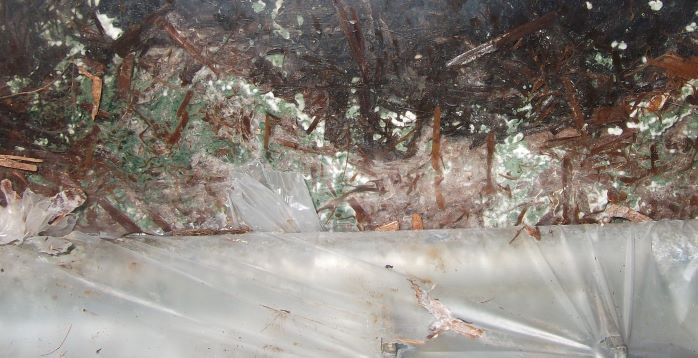Please click here to access the main AHDB website and other sectors.
- Home
- Knowledge library
- Symptoms and biology of Trichoderma aggressivum in mushrooms
Symptoms and biology of Trichoderma aggressivum in mushrooms
Trichoderma aggressivum thrives in mushroom farming conditions, spreading quickly to overwhelm crops. Early symptoms can be hard to spot – find out what to look for.
Symptoms
Trichoderma aggressivum starts by producing whitish mycelia, which can be hard to identify. Within three to five days, extensive sporulation develops, resulting in dark green patches of compost. It’s rare for mushrooms to develop in the affected green patches. If they do, they may be of poor quality or have visible red pepper mites on the caps.
Other symptoms include a subtle increase in compost temperature during bulk spawn run and after growing rooms have been filled, and a distinct smell.
If an infection has happened within a Phase 3 compost tunnel, there might not be any visible signs at tunnel emptying or shelf filling. However, the mushroom mycelium may seem slower in its growth and less interwoven through the compost.

Biology
There are several species of Trichoderma that have been identified, but what makes Trichoderma aggressivum more harmful to commercial mushroom crops is complex. Studies have shown:
- Many key features of mushroom cultivation – nutrition, warm temperatures and high relative humidity, absence of light in spawn run, are also ideal for aggressivum
- Under optimum conditions, aggressivum shows rapid growth and, therefore, can outcompete mushrooms for nutrients and space
- aggressivum also produce extracellular enzymes, toxic secondary metabolites, as well as volatile organic compounds and can tolerate inhibitory effectors of bacteria present in mushroom compost
- These characteristics, among others, result in intense competition, antagonism and/or parasitism that enable agressivum to grow successfully
Evidence shows that T. aggressivum does not sporulate readily in tunnels and that Trichoderma spores are not readily airborne, which could be a limiting factor to its dispersal within a mushroom tunnel. However, compost mixing by the compost winch at emptying, layering filling of compost into vehicles, shelf filling, and use of infected equipment can spread T. aggressvium throughout compost in a tunnel. All compost mixing operations should be considered high-risk activities.
Useful links
Monitoring Trichoderma aggressivum
How to manage Trichoderma aggressivum
Images are courtesy and copyright of: Mairead Kilpatrick (AFBI), Johan Baars (C4C Holding), Piet Liempens (Hooymans Compost BV), Brendan Burns (Sylvan) and Roland Mumm (Wageningen UR)

